How to Fix WSA Not Working on Windows 11?
Fix: Windows Subsystem for Android Not Working on Windows 11
Some Windows 11 users are reporting that the WSA (Windows Subsystem for Android) functionality is not working at all on Windows 11. Most affected users are reporting that the WSA popup appears but then nothing happens.
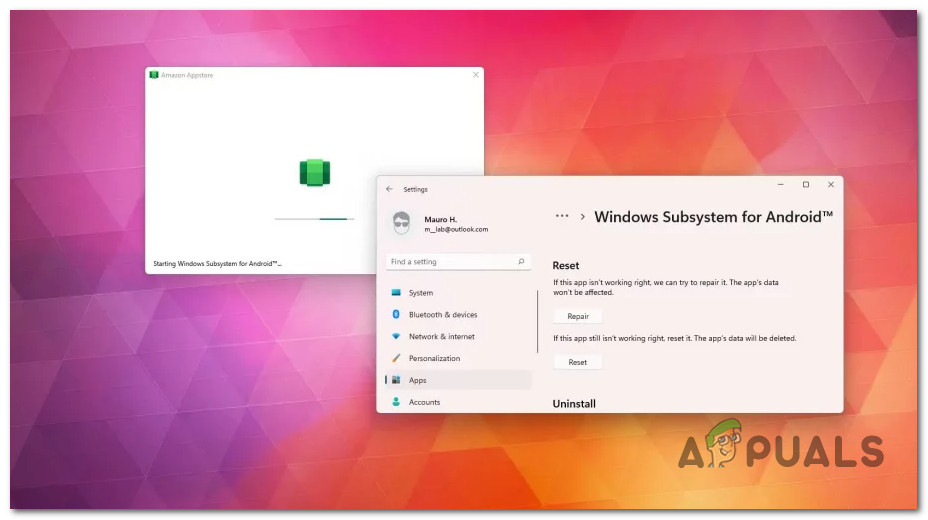
After investigating this particular issue thoroughly, it turns out that there are actually multiple potential scenarios that might ultimately cause this type of behavior on Windows 11. Here’s a shortlist of scenarios that might end up breaking the WSA (Windows Subsystem for Android) functionality on Windows 11:
- VPN software interference – One unlikely culprit but one of the most common causes of this particular issue on Windows 11 is some kind of VPN interference. NorthVPN and a few other similar tools are known to conflict with the Windows Subsystem for Android functionality. Unfortunately, there isn’t a way to resolve the conflict other than forcing the uninstallation of the conflicting VPN software.
- Outdated Microsoft Store framework – As it turns out, this particular issue can also be related to an outdated Microsoft Store outdated framework. Keep in mind that Microsoft has released a critical update for the WSA integration that needs to be installed in order to be able to use the Android Subsystem (especially if you’re using the latest available Windows 11 build).
- Corrupted WSA temporary files – If you’ve already used the WSA infrastructure and have successfully run some Android apps before you started experiencing this issue, chances are you’re dealing with some remnant temporary files that have stopped the Android subsystem in its tracks. To fix this, you’ll need to reset the entire Android Subsystem.
- Corrupted WSA installation – Another scenario that is known to cause this problem is a corrupted WSA installation that was interrupted. Additionally, you can find this issue occurring right after an AV suite ended up quarantining some files belonging to the WSA infrastructure. In this case, you should take the time to reinstall the android subsystem.
- Overprotective AV suite – As it turns out, VPN software is not the only thing that might ultimately interfere with the WSA functionality on Windows 11. As it turns out, there are several 3rd party AV suites that will simply prevent the Windows Subsystem for Android from running smoothly. In this case, the only fix that works consistently is uninstalling the interfering 3rd party antivirus suite.
Now that we weren’t over every potential scenario that might be responsible for this type of issue, let’s go over the actual fixes that should allow you to fix the Windows Subsystem for Android on Windows 11:
Resolve VPN conflict (if applicable)
If you’ve been using a VPN (virtual private network) tool keep in mind that there’s a high chance that it’s conflicting with the WSA functionality on Windows 11.
Note: Most commonly, NordVPN is reported for being responsible for this particular type of conflict.
We don’t have an official explanation from Microsoft on why this problem is occurring, but the connection is clear since we found dozens of affected users reporting that the problem was fixed immediately after they uninstalled the VPN suite.
I’m sure this type of conflict will eventually get patched by Microsoft eventually, but until that happens, the only viable fix is to simply uninstall the conflicting VPN software to ensure that the Windows Subsystem for Android is not interfered with.
If this scenario is applicable, follow the instructions below for specific instructions on uninstalling the VPN app that is most likely conflicting with the WSA infrastructure:
- Press Windows key + R to open up a Run dialog box. Next, type ‘appwiz.cpl’ and press Enter to open up the Programs and Features menu.
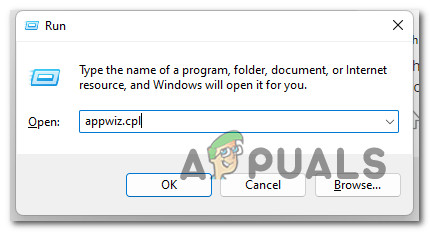
Open up the Programs and Features menu - If you’re prompted by the User Account Control (UAC), click Yes to grant admin access.
- Once you’re finally inside the Programs and Features menu, scroll down through the list of installed programs and locate the VPN software.
- After you manage to locate the correct listing associated with your VPN, right-click on it and choose Uninstall from the context menu.
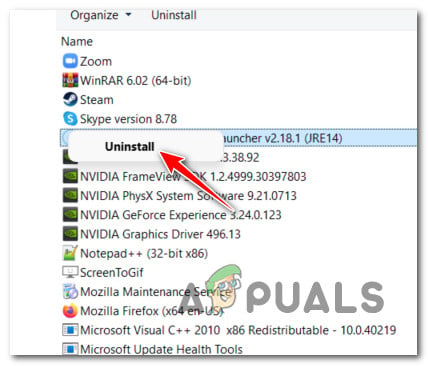
Uninstall the VPN software - Follow the on-screen prompts to complete the uninstallation, then reboot your PC and see if the WSA functionality is now fixed.
If the same kind of issue is still occurring even after you uninstalled the VPN tool (or this method was not applicable), move down to the next potential fix below.
Update the Microsoft Store Framework
If the first method was not applicable in your case or it didn’t allow you to fix the issue, the next thing you should troubleshoot for is a potentially outdated Microsoft Store framework.
Keep in mind that just recently, Microsoft has released a critical framework infrastructure update that essentially makes using the WSA integration impossible if it’s missing from your Windows 11 installation.
If you have updated your Windows 11 computer up to date but you have postponed the updates available for the Microsoft Store, that’s probably the reason why you’re experiencing issues with the Windows Subsystem for Android.
If you’re looking for specific instructions on how to update your Microsoft Store framework, follow the instructions below:
- Press Windows key + R to open up a Run dialog box. Next, type ‘ms-windows-store:’ inside the text box and press Enter to open up the Microsoft Store component.
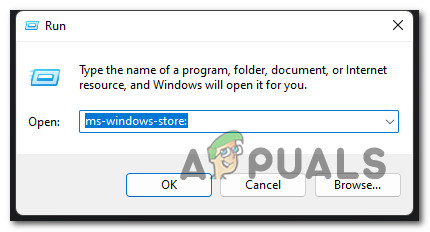
Accessing the Microsoft Store - Once you’re inside the home screen of the Microsoft Store, click on Library (bottom-left) corner of the screen.
- Next, move over to the right-hand section and click on the Update All hyperlink to install every pending update for apps and the MS framework.
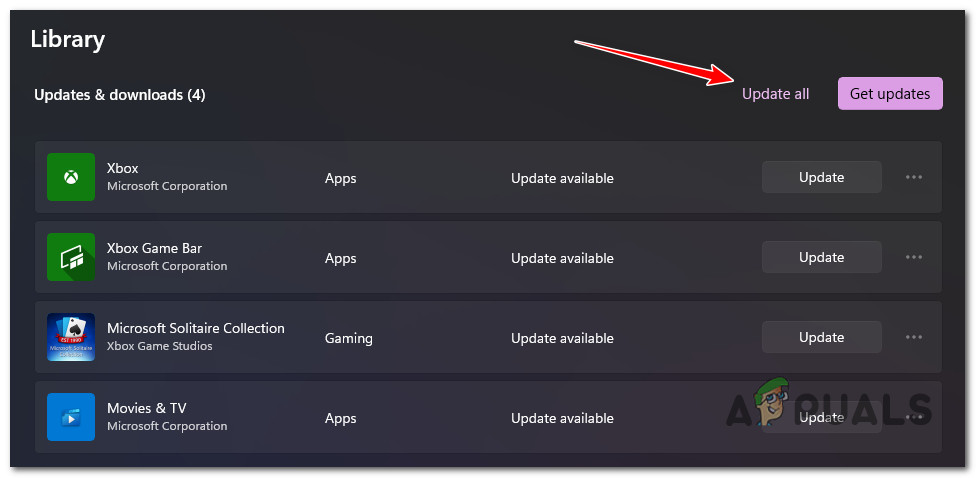
Install every pending Microsoft Store update - Once every pending Microsoft update is installed, reboot your PC and see if the Windows Subsystem for Android functionality is fixed once the next startup is complete.
If the same kind of problem is still occurring even after you installed the pending Microsoft Store framework updates, move down to the next potential fix below.
Reset the Android Subsystem
As it turns out, this particular issue can also be caused by a couple of temporary files that were generated after you deployed Android games via the WSA infrastructure.
Note: This method is only applicable to the WSA functionality used to work on your PC before stopping abruptly.
We managed to uncover a lot of user reports confirming that in their case, the problem was actually being caused by temp files related to the Android Subsystem. Upon resetting the entire WSA infrastructure, they managed to fix the problem permanently.
To reset the Android subsystem, you’ll need to do it from the Installed Apps tab of the Settings menu.
For specific steps on how to do this, follow the instructions below:
- Press Windows key + I to open up the Settings menu on Windows 11.
- Once you’re inside the Settings menu, click on Apps from the side menu on the left.
Note: Keep in mind that in case you don’t see the side menu on the left, you’ll need to click on the action icon (top-left corner of the screen) - After you successfully select the Apps menu, move over to the right-hand section and click on Installed apps.
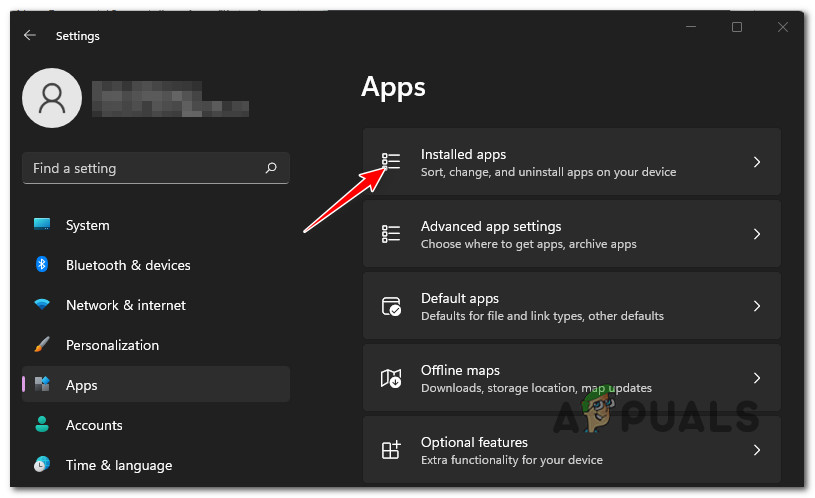
Open up the Installed apps menu - Once you’re inside the Installed Apps tab, use the search function at the top to search for ‘android’.
- From the list of results, click on the action icon associated with Windows Subsystem for Android, then click on Advanced Options from the context menu that just appeared.
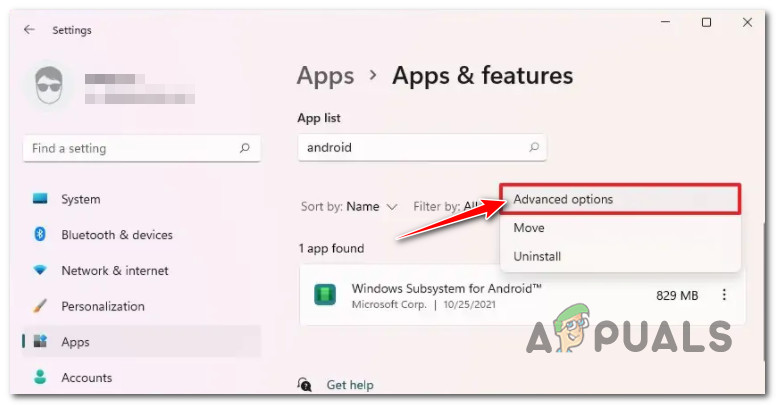
Accessing the Advanced Options for Windows Subsystem for Android - Once you’re inside the Advanced Options menu, scroll down to the Reset section, then click on the Reset button.
- At the confirmation prompt, click on Reset once again to start the process of resetting the Windows Subsystem for Android and clearing the cache files.
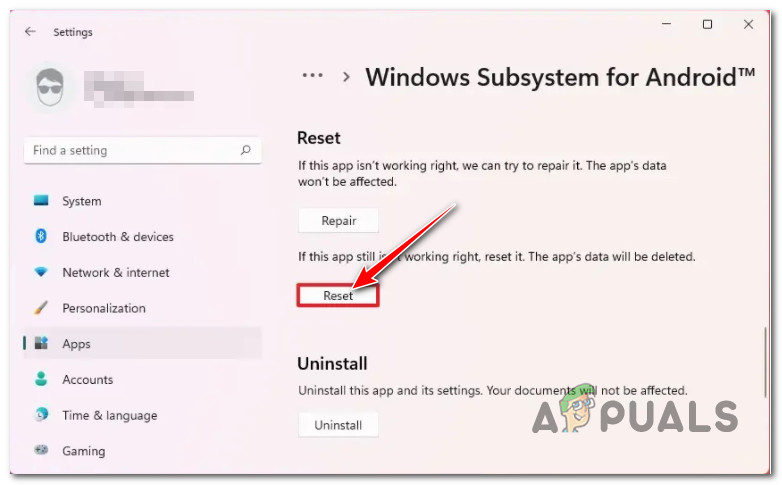
Resetting the Android for Subsystem - Once the operation is complete, reboot your PC and see if the WSA component has been fixed once the next startup is complete.
If you’re still dealing with the same kind of issue, move down to the next potential fix below.
Reinstall the Amazon Appstore
If you’ve come this far without a viable fix, you should also consider a potential corruption issue that is affecting the installation of the Windows Subsystem for Android. This type of issue is mostly linked to an AV suite quarantining some dependencies used by the Windows Subsystem for Android (Amazon Appstore).
As it turns out, this type of issue can only be resolved by uninstalling the entire WSA infrastructure, rebooting your system, and reinstalling the full component once again.
This type of fix has been confirmed for being successful by a lot of users that were previously able to use the subsystem for Android on Windows 11 before the component completely broke.
If you find yourself in this particular scenario, follow the instructions below:
- Press Windows key + I to open up the Settings menu.
- Once you’re inside the Settings menu, click on Apps from the side menu on the left.
- Next, move over to the right-hand section and click on Apps & features menu.
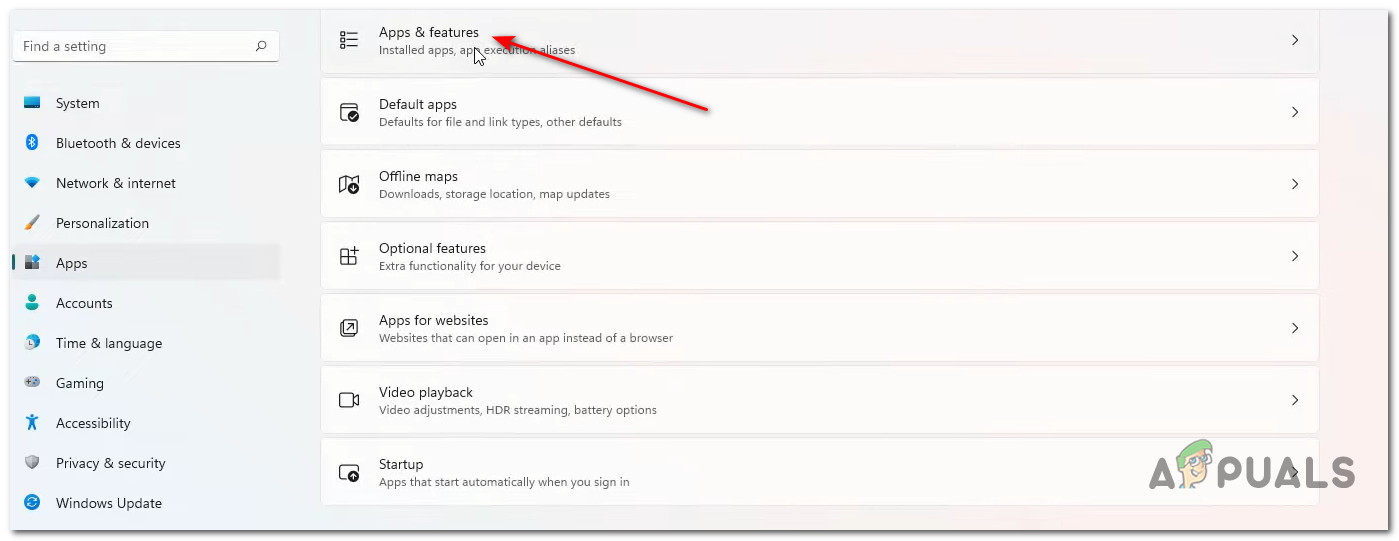
Open up the Apps & Features menu - Inside the Apps & Features section, type ‘amazon’ inside the search function, then hit Enter to find the Amazon Appstore.
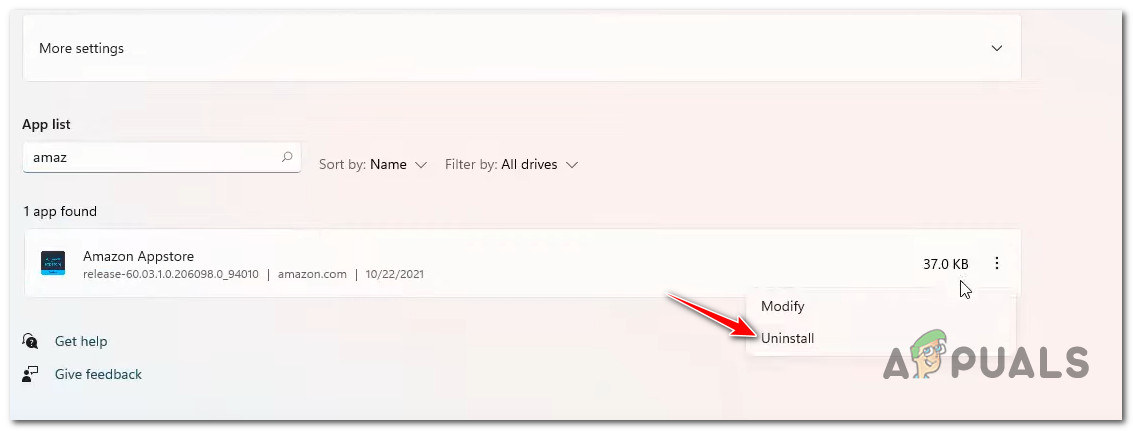
Uninstall the Amazon Appstore - Next, move down and click on the action button associated with Amazon Appstore and click Uninstall from the context menu that just appeared.
- At the confirmation prompt, confirm your choice by clicking on Uninstall once again, then wait until the uninstallation is complete.
- Reboot your PC and wait until the next boot process is complete.
- After your PC boots back up, press Windows key + R to open up the Run dialog box. Next, type ‘ms_windows-store:’ and press Enter to open up the Microsoft Store component.

Accessing the Microsoft Store - Once you’re inside the Microsoft Store component, use the search function at the top to search for Amazon Appstore, then hit the Install button.
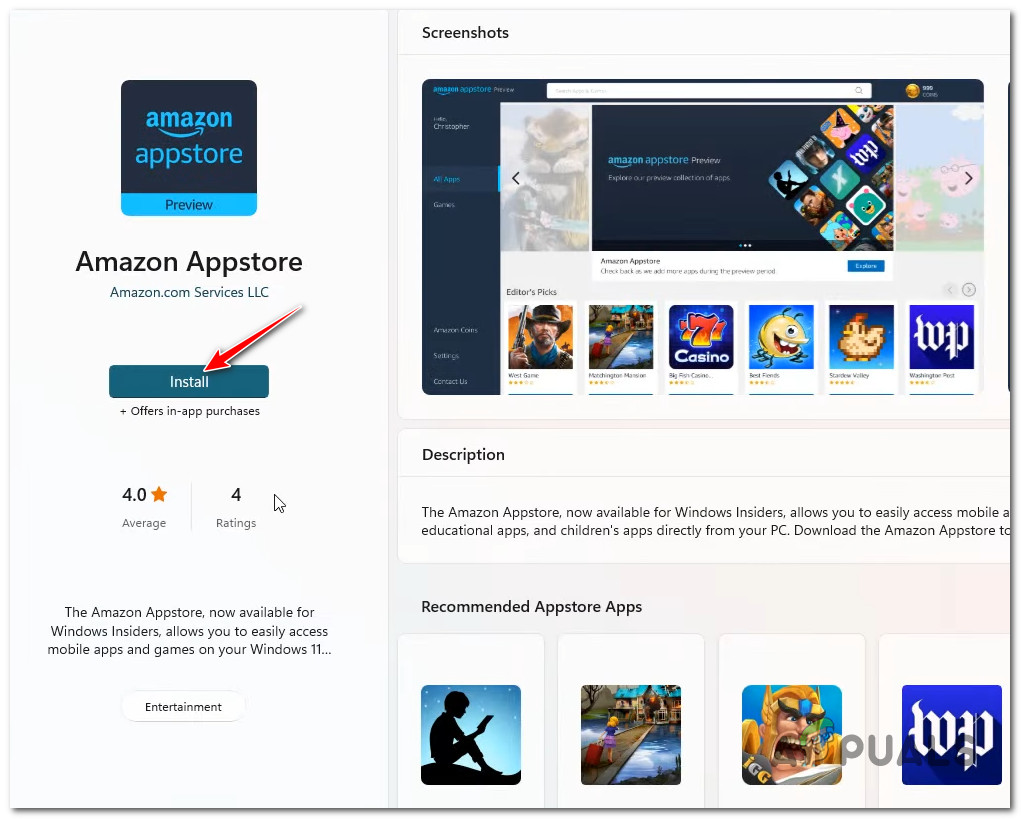
Install the Amazon Appstore - Wait until the installation is complete, then reboot your PC once again before checking if the WSA component is finally fixed.
If the same kind of issue is still occurring even after you reinstalled the Amazon Appstore, move down to the next potential fix below if the described scenario is applicable.
Uninstall 3rd party antivirus suite (if applicable)
If you’ve come this far without a viable fix, one last thing that you should absolutely troubleshoot for is a potential interference caused by an overprotective 3rd party antivirus suite.
The Windows Subsystem for Android (powered by Amazon Appstore) seems to conflict with a lot of second-tier 3rd party Antivirus suites. Zone Alarm and Comodo are often blamed for crippling the functionality of WSA on WIndows 11.
Unfortunately, there is no way to exclude the WSA files from the scope of your 3rd party AV (since a lot of kernel dependencies are used), so the only way to fix this problem (if it’s applicable) is to simply uninstall the overprotective suite.
Follow the instructions below to uninstall the overprotective 3rd party antivirus suite that’s supposedly interfering with the Windows subsystem for Android:
- Press Windows key + R to open up a Run dialog box. Next, type ‘appwiz.cpl’ and press Enter to open up the Programs and Features menu on Windows 11.
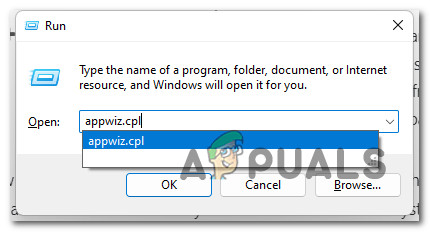
Opening up the Programs and Features menu - If you’re prompted by the User Account Control, click Yes to grant admin access.
- Once you’re inside the Programs and Features menu, scroll down through the list of installed programs to locate the interfering AV suite.
- After you locate the problematic AV suite, right-click on it and choose Uninstall from the context menu.
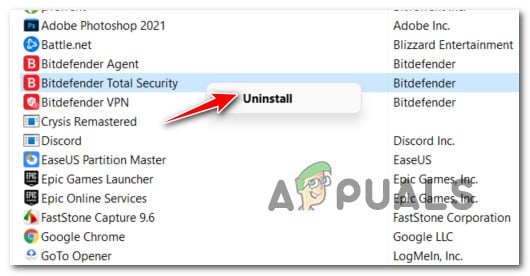
Uninstall the antivirus conflicting with WSA - Follow the uninstallation prompts to complete the process, then reboot your PC and see if the WSA component is fixed once the next startup is complete.





